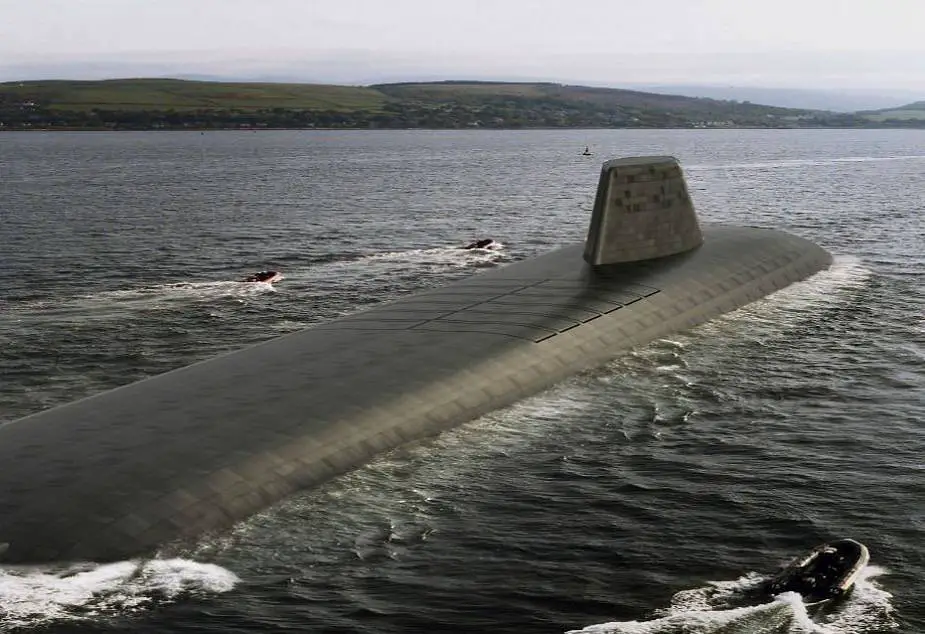Breaking news
General Dynamics receives contract to produce Colombia-class and Dreadnought-class ballistic missile submarines.
According to information released by the U.S. Department of Defense on June 10, 2020, American Company General Dynamics Mission Systems, Pittsfield, Massachusetts, is awarded a $104,214,429 cost-plus-incentive-fee, cost-plus-fixed-fee, and cost-no-fee contract (N00030-20-C-0003) for fiscal 2020-2023 Columbia (US01) and Dreadnought ballistic missile submarine class development, production and installation requirement.
Follow Navy Recognition on Google News at this link
 An artist rendering of the future U.S. Navy Columbia-class ballistic missile submarines. (Picture source Wikimedia)
An artist rendering of the future U.S. Navy Columbia-class ballistic missile submarines. (Picture source Wikimedia)
Work will be performed in Pittsfield, Massachusetts (90%); the United Kingdom (6%); Quonset Point, Rhode Island (3%); and Groton, Connecticut (1%). Work is expected to be complete by November 2024. The U.S. Department of Defense’s 2010 Nuclear Posture Review calls for recapitalization of the nation’s sea-based deterrent. In order to meet this requirement the U.S. must begin construction of the lead ship of the Columbia Class (formerly Ohio Replacement) program in FY2021. Because these submarines will remain in service until 2080, they must provide cost-effective, state-of-the-art design and technology to ensure survivability. Efforts to reduce the design, construction and life cycle costs are a primary focus of the program.
The Columbia (SSBN-826) class program is a program to design and build a class of 12 new ballistic missile submarines (SSBNs Sub Surface Ballistic Nuclear) to replace the Navy’s current force of 14 agings Ohio-class SSBNs.This generation of submarine is being built by American company General Dynamic subsidiary Electric Boat for the US Navy in collaboration with Newport News Shipbuilding. The first-of-class Columbia was initially expected to be delivered to the U.S. Navy by 2028.
The Columbia-class design includes 16 SLBM tubes, as opposed to 24 SLBM (submarine-launched ballistic missile) tubes (of which 20 are now used for SLBMs) on Ohio-class SSBNs. Although the Columbia-class design has fewer SLBM tubes than the Ohio-class design, it is larger than the Ohio-class design in terms of submerged displacement.
The electric-drive propulsion system on board the Columbia-class ballistic missile submarines will include an electric motor driving the propeller of the boat. The propulsion system will enable the submarine to sail at a speed of more than 20 k and operate at a depth of 800 ft.

An artist rendering of Dreadnought ballistic missile submarine class for British Navy. (Picture source Wikimedia)
The Dreadnought class is the future replacement for the Vanguard-class of ballistic missile submarines in service with the British Navy. The Vanguard submarines entered service in the United Kingdom in the 1990s with an intended service life of 25 years.[5] Their replacement is necessary if the Royal Navy is to maintain a continuous at-sea deterrent (CASD), the principle of operation behind the Trident system.
According to the Naval Technology website, the Dreadnought class submarine will have a length of 153.6 m and displacement of 17,200 t. It will have a crew of 130 sailors.
The Dreadnought-class submarine will be installed with eight operational missile tubes for launching Trident II D5 missile that can carry nuclear warheads. Four additional tubes will be configured with ballast. The Trident ballistic missile is a solid-fuel, inertial-guided missile that can carry multiple W76-Mk4/Mk4A or W88-Mk5 re-entry bodies. It has an operational range of 4,000 nm (7,36 0km).
The Dreadnought-class submarine will be powered by Rolls-Royce nuclear propulsion system known as Pressurised Water Reactor 3 (PWR3). The MoD considered three PWR options, including PWR2, PWR2b, and PWR3. The PWR3 propulsion system incorporates a new design and leverages technology to deliver benefits such as simplified operations, longer service life, and reduced maintenance costs over the lifecycle.


























